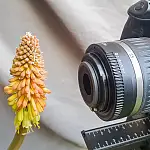A Comparison of Close-up Filters and Macro LensesA comparison of close-up filters and macro lenses. How good are closeup filters for the price and how much better is a macro lens?
A comparison of close up filters and macro lenses. How good are closeup filters for the price and how much better is a macro lens? What kind of results can be obtained using close-up filters, and what is the difference compared with a dedicated macro lens? What is the difference between a macro lens close to the subject vs. a telephoto lens further away?
What is a Close-up Filter?
A close-up filter is a lens that attaches to the end of a camera lens via a screw thread. The purpose of the filter is to decrease the minimum distance that a lens requires focusing. For example, most telephoto lenses need the subject to be at least a metre and a half away before they can focus. By attaching a close-up filter to the lens you can reduce this to maybe 0.75 metres.

Close-up filters are measured in Dioptre, with +2 being weak and +10 being strong. A dioptre is a measure of lens power.
Filters can be "stacked" together (one filter screwed onto the lens and another screwed into the first filter). When stacking filters always make sure that the strongest filter is closest to the lens.
Equipment Used to Compare Close-up Filters and Macro Lenses
- Canon EOS 350d Digital SLR
- Canon 18-55mm EFS USM Lens (As sold in the Canon Bundle)
- Canon 55-200mm EF USM Lens (As sold in the Canon Bundle)
- Canon 60mm EFS USM Macro Lens
- Hoya +2 Close-up Filter
- Hoya +3 Closeup Filter
- Hoya Step up/down adaptor rings
- Manfrotto 055PROB Tripod
Settings and Post Process
All of the photos were taken on the same day, with the same camera and settings. The camera was in manual mode with an aperture set to f/11, ISO 100 and variable shutter speed. A camera 10-second timer was used to reduce the effect of vibrations. I will be using an English 50-pence coin for the subject. The coin is slanted at approx 55 degrees away from the camera resulting in about a 12mm difference in depth between the top edge (furthest) and bottom edge (closest). In each image, the camera was on auto focus and directed at the G of REG.F.D top right.
For my friends outside the United Kingdom, here is a scale to show the size of the coin.
Each image has been resized to 800 by 533 pixels and saved in JPEG format. Due to the way the file format works, some image quality will be lost, however, I have saved the images with a fairly low compression setting.
The Tests
Canon 18-55mm Lens No Filter
To start with, here is the closest focal distance for the basic Canon lens with no filters. The lens is at its maximum 55mm focal length. The photo appears to be nice and sharp with good detail shown and not very many distortions. The closest to the subject I could obtain focus was 115mm between the lens and the target, which results in a small image on the sensor.
Canon 18-55mm Lens +2 Close-up
Adding a +2 Close-up filter enables the camera lens to get 25mm closer to the subject which results in a larger image on the sensor. There is a noticeable decrease in the depth of field towards the bottom of the image, but overall it remains sharp without visible distortions.
Canon 18-55mm Lens +3 Close-up
By attaching a +3 Close-up filter to the lens I was able to move the camera closer to the subject again and still keep focus, this time the subject was 85cm away from the lens. The improvement in magnification is clearly shown in the 100% crop and even clearer in the original image. The depth of field has noticeably decreased and the photo does not appear quite so sharp.
Canon 18-55mm Lens +3 and +2 Close-up
Closer again at 75cm between the lens and the subject, however, the reduced depth of field has caused much of the image to blur. There are also some chromatic aberrations visible around the edge of the coin
Canon 55-200mm Lens No Filter
From 1 metre away the coin looks small, even through a 200mm focal length. There is not much detail and the writing is blurry.
Canon 55-200mm Lens +2 Close-up
As you can see the coin fills much of the frame, but is of poor quality. The focal distance is reduced with a +2 filter down to 340mm. The left-hand side of the coin is blurred, even the area the camera thinks is in focus has a soft feel to it. This lens does not seem to be able to cope with macro work!
Canon 55-200mm Lens +3 Close-up
With a focal distance now of 290mm, the camera is having trouble focusing on the coin. It is taking several attempts to get the 'beep beep' alert. Even then it is struggling. The coin is out of focus around much of the surface, only a few mm around the focus area are acceptable.
Canon 55-200mm Lens +3+2 Close-up
Using a +3 and a +2 filter has given a much larger image, close to 1:1, due to its focal distance of 170mm. However, the image has also become too blurred to be of practical use. There is far too much distortion from the double filters, and the quality of the 200mm lens isn't the best. There are clear chromatic aberrations all around the image.
Canon 60mm Macro Lens No Filter
These images just speak for themselves. They are comparable in size with the 200mm lens and a +3 Close-up filter and focus is achieved from 85mm, however, the quality of the image is far superior to any of the other combinations. Not surprising considering that the macro lens is dedicated to macro photography while the other two lenses are general-purpose and kit lenses.
Just Curious...
How would the macro lens work with a close-up filter? I am writing this section the day after the rest of the tests and the photography set have been dismantled, but I was curious as to what the images would look like and how much detail they have, so I set up again and took a few more pictures. Because these images are not taken at the same time as the rest they cannot be directly compared with those above. The above photos were taken in the shade on a bright sunny afternoon, today I am indoors and it is raining outside. I have tried to keep everything as close as possible to yesterday's work.
These were taken with the 60mm Macro lens and a +3 Close-up filter. At first glance, these images look better than those without the filter but remember that the light is completely different in these images, and the coin is at a different angle from the camera. This level of detail is unbelievable, you must download the full image below to see how much detail has been captured. The focus was achieved from only 60mm.
The letters are measured at 2mm in height, which means that the dot is 0.39mm in diameter! The scratches by the F aren't even visible to the eye.
Conclusions
It's clear that if you are after pin-sharp images close to 1:1 magnification then you need a good macro lens because close-up filters just cannot offer that level of detail with the lens bundled with the camera. If you just want to get a bit closer to the subject then a single filter will help reduce the focal distance, but the larger the dioptre the more distortion will creep in. With two filters stacked, the camera found it difficult to auto-focus, and the lack of quality reduces the image to nearly useless for macro work. If you need to stack filters, it's probably worth purchasing a higher dioptre filter (e.g. +5).
So you get what you pay for, in the end, Close-up filters have their uses and are good to start you off in macro work, however, to capture the fine details you can't beat a macro lens.
































